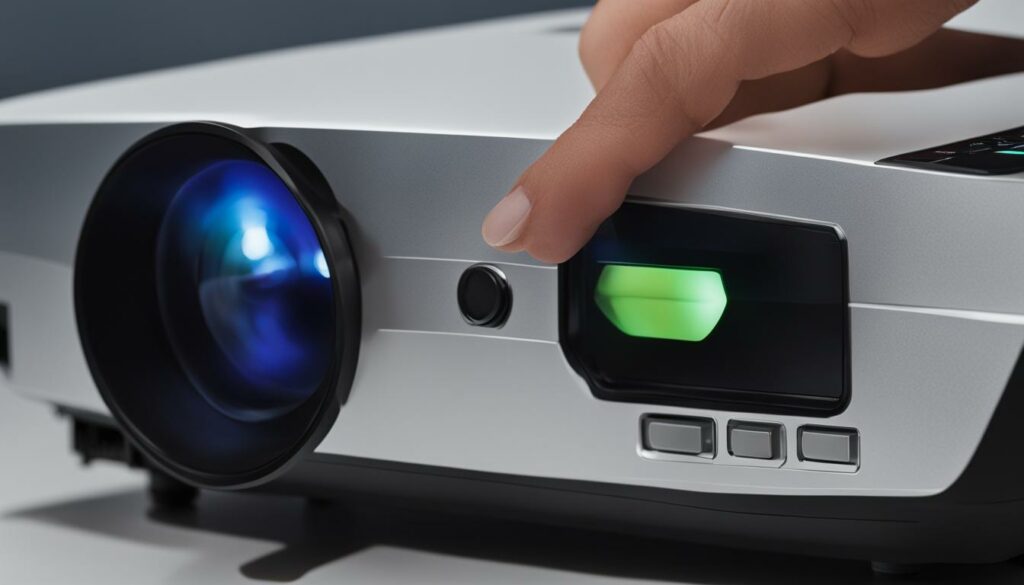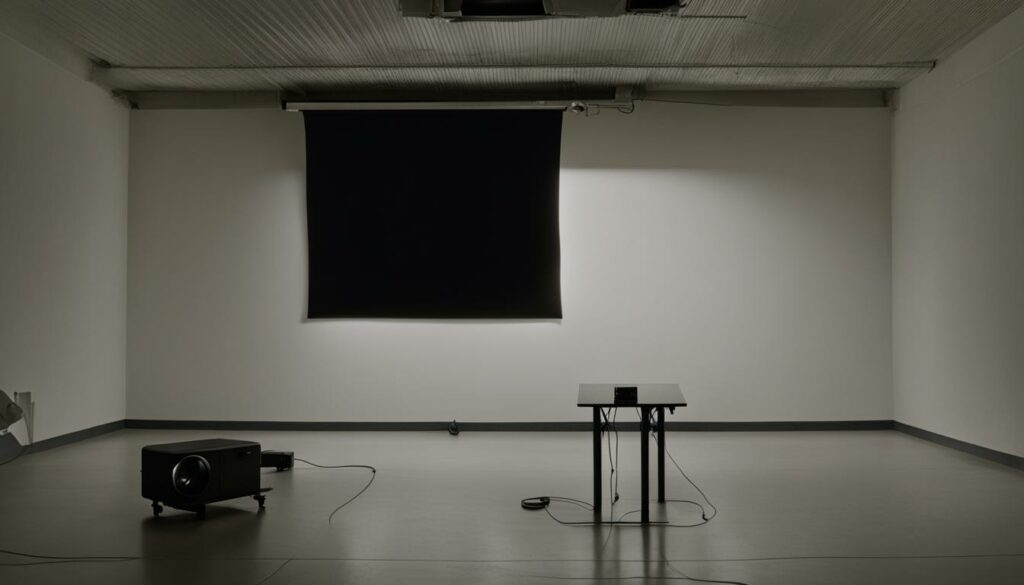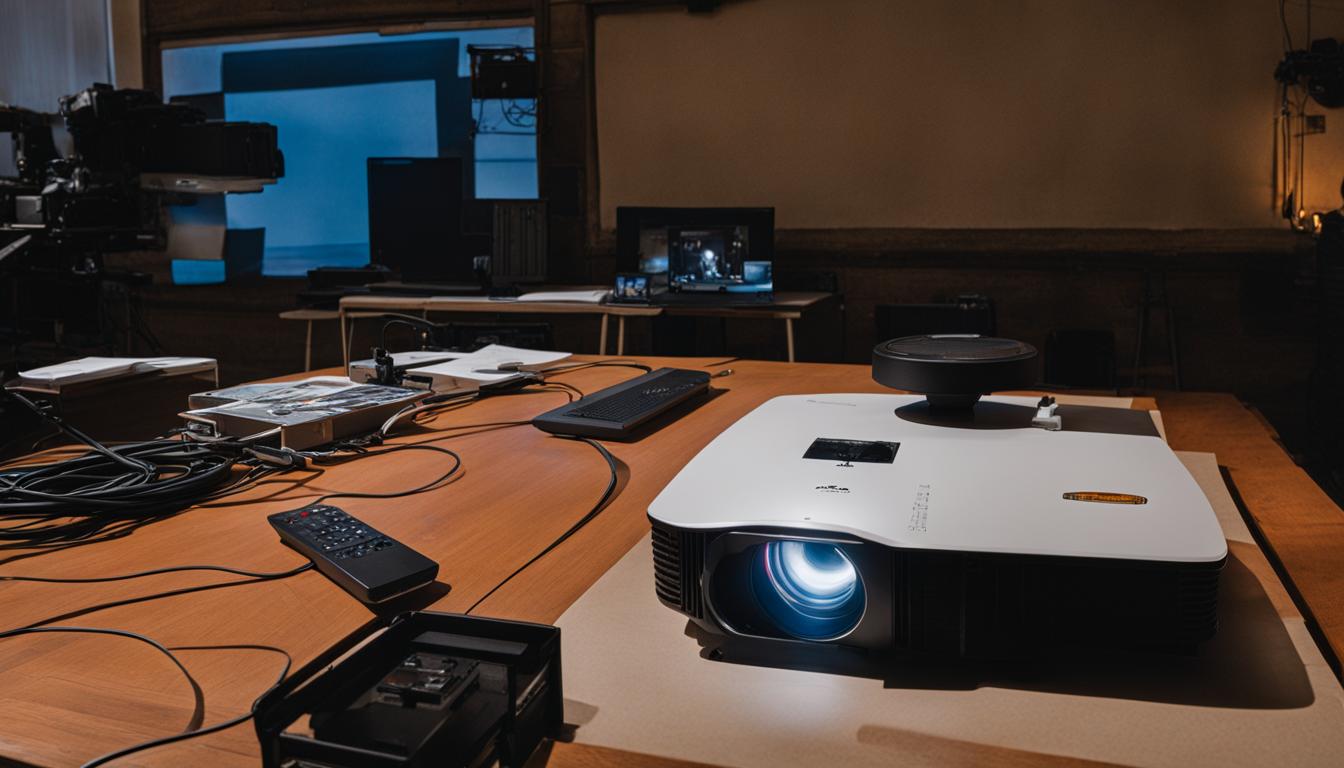Welcome to our step-by-step guide on how to use a projector without a remote control. Whether your remote is lost, broken, or simply unavailable, we’ve got you covered. In this article, we will walk you through various methods to operate your projector without the need for a remote control. So, grab your popcorn, and let’s dive in!
Have you ever found yourself in a situation where you want to enjoy a movie night or make a presentation, but you can’t find your projector remote? Don’t worry, there are alternative ways to control your projector!
In the following sections, we will explore different methods you can use to operate your projector without a remote control. From using the power button on the projector itself to utilizing a smartphone app, we will cover all the bases. So, no matter the circumstances, you’ll always be able to enjoy a seamless projector experience.
Stay tuned for the next section where we’ll delve into the first method: using the power button on the projector. Get ready to take control of your projector without the need for a remote!
Method 1: Using the Power Button on the Projector
One of the simplest methods to turn on a projector without a remote is to use the power button on the projector itself. By locating the power button and pressing and holding it for a few seconds, you can power on the projector. This method provides basic control over turning on the projector but may require additional adjustments using other methods.
Manual Control of Projector
- Locate the power button on the projector.
- Press and hold the power button for a few seconds until the projector powers on.
- If necessary, adjust the focus, keystone, and other settings manually using the control panel on the projector.
Using the power button on the projector is a quick and straightforward way to turn on the device without the need for a remote control. However, keep in mind that this method may not provide access to all the features and settings available on the projector. For more precise control, consider utilizing other methods such as the control panel, a universal remote control, or a smartphone app.
| Pros | Cons |
|---|---|
| Simple and easy to use | Limited control over projector settings |
| No need for additional devices | May require additional adjustments using other methods |
Method 2: Using the Control Panel on the Projector
If you find yourself without a remote control for your projector, don’t worry. You can still operate and control your projector using the control panel located on the device itself. This method allows you to navigate through menu options, adjust settings, and power on the projector without the need for a remote control.
To get started, locate the control panel on your projector. It is usually positioned on the top or front of the device. The control panel typically consists of buttons or a joystick that allows you to interact with the projector’s functions.
Once you have located the control panel, find the power button and press it. This will turn on the projector and you will see the device powering up. Depending on your projector model, you may need to press and hold the power button for a few seconds to initiate the power-on sequence.
After powering on the projector, you can use the control panel to navigate through the various settings and options. This may include adjusting the brightness, contrast, and aspect ratio, as well as selecting input sources and accessing on-screen menus. By familiarizing yourself with the control panel layout and functions, you can easily operate your projector even without a remote control.

Control Panel Buttons and Functions
| Button | Function |
|---|---|
| Power | Turns the projector on/off |
| Menu | Opens the on-screen menu for accessing settings |
| Navigation Buttons | Navigates through menu options and settings |
| Enter/OK | Selects a menu option or confirms a setting |
| Source/Input | Selects the input source for the projector |
As you can see, the control panel provides a range of buttons and functions to control and operate your projector without a remote. By using the power button to turn on the device and the other buttons to navigate through the settings, you can enjoy a seamless projector experience even without the convenience of a remote control.
Next, we will explore another method for controlling a projector without a remote control: using a universal remote control.
Method 3: Using a Universal Remote Control
If you don’t have access to the original remote control for your projector, don’t worry! There is an alternative solution – a universal remote control. A universal remote control is a device that can be programmed to work with various electronic devices, including projectors. By programming the universal remote control to communicate with your projector, you’ll be able to control it without the need for the original remote.
Using a universal remote control to operate your projector provides convenience and ease of use. You can turn the projector on and off, adjust the volume, change input sources, and even access menu options directly from the universal remote control. It acts as a replacement for the original remote and gives you full control over your projector’s functionality.
To use a universal remote control with your projector, follow these simple steps:
Step 1: Find a Compatible Universal Remote Control
Start by finding a universal remote control that is compatible with your projector model. Look for a universal remote control that supports your projector’s brand and model number. You can search online or visit an electronics store to find a suitable option.
Step 2: Program the Universal Remote Control
Once you have obtained a compatible universal remote control, you’ll need to program it to work with your projector. Consult the user manual of the universal remote control for instructions on how to program it. The process usually involves inputting a specific code into the universal remote control or following a series of button presses.
Step 3: Test the Universal Remote Control
After programming the universal remote control, test it to ensure it is functioning correctly with your projector. Press the power button on the universal remote control to turn on the projector. Try adjusting the volume, changing input sources, and accessing menu options to verify that the universal remote control is working as intended.
Using a universal remote control is a great option for controlling your projector without the original remote. It provides convenience and flexibility, allowing you to operate your projector with ease. By following the steps mentioned above, you can successfully set up and use a universal remote control for your projector.
Method 4: Using the Function Button on the Projector
If you find yourself without a remote control for your projector, don’t worry! There’s another method you can use to control the device. Some projectors come equipped with a dedicated function button on their control panel. This function button allows you to turn the projector on and off without needing a remote control.
To use this method, simply locate the function button on the projector’s control panel. Once you’ve found it, navigate to the power or on/off option by using the arrow buttons or other navigation controls on the panel. Once you’ve selected the power option, confirm your selection to power on the projector. It’s as simple as that!
Method 5: Using a Smartphone App
With advancements in technology, many projectors can now be controlled using smartphone apps. By downloading and installing a compatible app for your projector, connecting your smartphone to the projector, and accessing the power control section within the app, you can turn on the projector without a remote. This method offers the convenience of controlling the projector from your smartphone.
Using a smartphone app to control your projector offers several advantages. Firstly, it eliminates the need for a physical remote control, which can easily be misplaced or damaged. With the app installed on your smartphone, you always have a convenient and readily accessible control option. Additionally, the smartphone app often provides more advanced control features and settings compared to a traditional remote control. You can easily adjust image settings, select input sources, and even access additional functions and settings specific to your projector model.
To use your smartphone as a remote control for your projector, follow these steps:
- Ensure that your projector and smartphone are connected to the same Wi-Fi network.
- Download and install the compatible projector control app from your smartphone’s app store.
- Launch the app and follow the on-screen instructions to connect to your projector.
- Navigate to the power control section within the app.
- Tap the power button or toggle to turn on the projector.
Using a smartphone app to control your projector provides a convenient and user-friendly alternative to physical remote control. It allows you to easily control your projector’s functions, settings, and power without the need for an additional device. Make sure to select a compatible app for your projector model and follow the manufacturer’s instructions for setup and usage.
Troubleshooting Remote Control Issues
Having trouble with your projector remote control? Don’t worry, we’ve got you covered. In this section, we will provide some troubleshooting tips to help you resolve common remote control problems. Whether your remote control is not working or you’re experiencing connectivity issues, these troubleshooting steps can help you get your projector back up and running.
Checking the Batteries
One of the first things to check when your projector remote control is not working is the batteries. Ensure that the batteries are properly inserted in the remote control and that they have sufficient power. If the batteries are low, replace them with fresh ones and see if the remote control functions properly.
Line of Sight and Interference
Another common issue with remote controls is a lack of line of sight or interference. Ensure that there are no obstacles between the remote control and the projector. Sometimes, other electronic devices or light sources can interfere with the remote control signal. Try eliminating any potential sources of interference or adjusting the position of the remote control to establish a clear line of sight with the projector.
Resetting the Remote Control
If your remote control continues to have issues, try resetting it. Remove the batteries from the remote control and press each button for a few seconds to discharge any residual power. Then, reinsert the batteries and test the remote control again. This can often resolve any minor glitches or software errors that may be causing issues.
If none of these troubleshooting steps work, you may need to consider replacing your remote control. Contact the manufacturer or a reputable retailer to find a compatible remote control for your projector model.
| Issue | Troubleshooting Steps |
|---|---|
| 1. Check batteries and replace them if necessary 2. Ensure a clear line of sight between the remote and the projector 3. Reset the remote control 4. Consider replacing the remote control | 1. Check batteries and replace if necessary 2. Ensure a clear line of sight between remote and the projector 3. Reset the remote control 4. Consider replacing the remote control |
| Connectivity issues | The remote control not working |
By following these troubleshooting tips, you can increase the chances of resolving remote control issues with your projector. Remember to always consult your projector’s user manual for specific instructions and reach out to customer support if you need further assistance.

Securing and Maintaining Your Remote Control
Maintaining the functionality and longevity of your projector remote control is essential for a seamless and hassle-free viewing experience. By following some simple tips, you can keep your remote control secure and in optimal condition.
Designate a Dedicated Storage Spot
To prevent misplacing or losing your remote control, designate a specific spot to store it when not in use. Choose a convenient and easily accessible location near your projector or entertainment center. This dedicated storage spot will help you keep track of your remote control and minimize the risk of it being misplaced.
Avoid Exposure to Liquids and Extreme Temperatures
Remote controls are sensitive electronic devices that can be easily damaged by exposure to liquids and extreme temperatures. To protect your remote control, avoid placing it near beverages or other liquids that could accidentally spill. Additionally, keep it away from direct sunlight, heaters, or any other heat sources, as excessive heat can cause internal components to malfunction.
Use a Protective Case
To safeguard your remote control from accidental drops, scratches, or other physical damage, consider using a protective case. There are various types of cases available, ranging from silicone covers to hard-shell cases. Choose one that fits your remote control model and provides adequate protection without obstructing the buttons or infrared sensor.
Educate Users About Proper Handling
Whether you’re using the projector remote control in a home theater setup or a classroom environment, it’s important to educate users about proper handling. Remind them to handle the remote control with care, avoid pressing the buttons forcefully, and always return it to its designated storage spot after use. By promoting responsible handling, you can reduce the risk of accidental damage or loss.
Have a Backup Plan
Despite taking precautions, there may be situations where you misplace or damage your remote control. To ensure uninterrupted projector control, it’s wise to have a backup plan in place. Consider purchasing a spare remote control or exploring alternative control methods such as smartphone apps or universal remote controls that are compatible with your projector model. Having a backup option will help you avoid any inconvenience if the primary remote control becomes unavailable.
By implementing these tips, you can maintain the security and functionality of your projector remote control, ensuring a smooth and enjoyable viewing experience. Remember to designate a dedicated storage spot, avoid exposure to liquids and extreme temperatures, use a protective case, educate users about proper handling, and have a backup plan if needed. With these practices in place, you can confidently control your projector and focus on enjoying your favorite movies, shows, or presentations.
Conclusion
There are several ways to use a projector without a remote control. Whether you choose to use the power button on the projector itself, the control panel, a universal remote control, or a smartphone app, you have options for controlling your projector without the need for a remote. These methods allow you to turn on the projector and adjust its settings to suit your needs.
Additionally, troubleshooting common remote control issues can help you overcome any obstacles you may encounter. By checking the batteries, ensuring a clear line of sight, resetting the remote control, and minimizing interference, you can keep your remote control functioning properly.
To maintain a seamless projector experience, it is important to secure and maintain your remote control. Designating a dedicated storage spot, protecting it from liquids and extreme temperatures, using a protective case, educating users, and having a backup plan can all contribute to the longevity of your remote control.
Remember, with the various methods available and a little troubleshooting and maintenance, you can confidently use and control your projector without a remote control.
FAQS
1. How Can I Turn On A Projector Without A Remote Control?
There are several methods you can use to turn on a projector without a remote control. These include using the power button on the projector itself, the control panel on the projector, a universal remote control, or a smartphone app.
2. How Do I Use The Power Button On The Projector To Turn It On?
To turn on the projector using the power button, locate the power button on the projector and press and hold it for a few seconds.
3. Can I Use The Control Panel On The Projector To Turn It On?
Yes, you can use the control panel on the projector to turn it on. Simply find the power button on the control panel and press it.
4. Is It Possible To Control A Projector Without A Remote Control Using A Universal Remote?
Absolutely! By programming a universal remote control to work with your specific projector model, you can turn on the projector and control various functions.
5. How Do I Turn On The Projector Using The Function Button On The Control Panel?
Locate the function button on the control panel of the projector, navigate to the power or on/off option, and confirm the selection to turn on the projector.
6. Can I Control A Projector Without A Remote Using A Smartphone App?
Yes, many projectors can now be controlled using smartphone apps. Download and install a compatible app for your projector, connect your smartphone to the projector, and access the power control section within the app to turn on the projector.
7. What Should I Do If I Encounter Issues With My Remote Control?
If you experience problems with your remote control, you can troubleshoot the issue by checking the batteries, ensuring line of sight, resetting the remote control, and checking for interference.
8. How Can I Secure And Maintain My Remote Control?
To keep your remote control secure, designate a dedicated storage spot, avoid exposing it to liquids and extreme temperatures, use a protective case, educate users about proper handling, and have a backup plan in case it gets lost or damaged.
